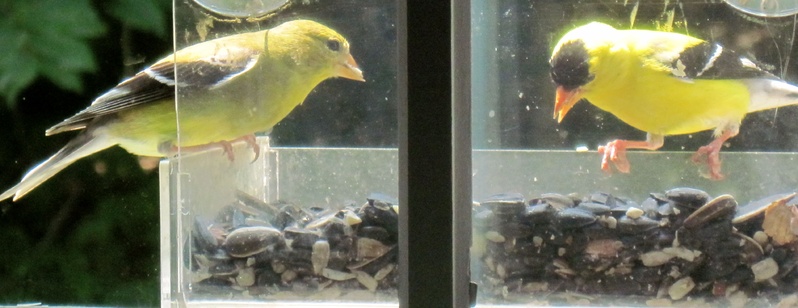Most of our breeding songbirds have fledged young by now. One species, however, is just getting started. That species is the American goldfinch.
Male goldfinches in their summery finery are well known by all. However, the more drab, olive-colored female is sometimes confusing. In the winter when both sexes are dull, misidentifications sometimes occur.
The American goldfinch is a member of the finch family, the Fringillidae. Other finches, like the house finch, evening grosbeak and pine siskin, do not undergo a complete molt in the spring. Not so the goldfinch. These birds molt all of their body feathers. Males are transformed from a muted olive color to the beautiful yellow and black of the breeding season.
I am sure you have enjoyed watching the transformation of goldfinches in the spring. First, a little yellow appears, gradually replacing all of the duller feathers.
Why do goldfinches begin nesting so late in the season? Some ornithologists think their spring molt may be the explanation. Molting is an energetically expensive activity. Replacing all of the body feathers is a lot more costly than replacing only some of the feathers, as seen in other North American finches. American goldfinches may need some time in the early summer to recover from the demands of the molt process.
Other ornithologists have noted that American goldfinch nesting seems to be closely tied to the flowering of thistle plants. Courtship usually begins about the time that thistle flowers appear. the time the eggs have hatched, thistle seeds are available for the parents to feed themselves and their young.
In flight, goldfinches have a characteristic undulating flight. They beat their wings a few times to gain a little altitude and then fold their wings tightly against the body and glide for a bit, losing a little bit of altitude.
During courtship, look for a couple of flight displays that are distinctly different from the normal undulating flight. One type is called butterfly flight. A male will fly with steady, slow wing beats, maintaining a constant height above the ground. The male circles over a prospective nesting area, singing its rambling, warbling song.
The displaying male is frequently joined by other males, all circling over a nesting area and singing. Quite a display to see.
Later in the breeding season, the moth flight can be seen. A male uses rapid wing beats to hover for a short period of time. This display is seen just before mating. Sometimes, a female will perform the moth flight.
Nests are most often built in scrub habitats, usually in a deciduous shrub. Both sexes seem to be involved in selecting a nest site, but only the female constructs the nest.
Unlike many nesting birds, American goldfinches do not usually defend a breeding territory for the duration of the nesting season. A male goldfinch may defend a nest site while the female is building the nest. Otherwise, males tolerate the incursion of other goldfinches into their breeding area.
Five eggs is the typical clutch size, although as many as seven and as few as two eggs have been found in some nests.
The female does all the incubation of the eggs. The female often spends long periods of time on the nest and is fed by her mate. Eggs hatch usually after 12 to 14 days.
Both parents feed the nestlings, but the male shoulders more of the responsibility.
Some nestlings may leave the nest after 11 days, while others may not leave until 17 days after hatching.
Because of the late start to the nesting process in goldfinches, these birds are usually restricted to a single clutch per season.
Although goldfinches are regulars at bird feeders, learning some of their calls will allow you to detect goldfinches flying overhead. A characteristic flight call can be rendered as per-chi-co-ree or “potato chip.”
Goldinches also have a characteristic, whiny note, which serves as an alarm call. The scientific name of the goldfinch is Carduelis tristis; tristis means sad and refers to this whiny call.
Goldfinches are widely distributed throughout North America, so these wonderful birds are well known to all birders.
In much of the United States, goldfinches are resident birds, although sometimes birds will migrate further south for the winter.
In southern Canada, goldfinches are only found in the summer, while in the southern tier of states, only wintering goldfinches are expected.
Herb Wilson teaches ornithology and other biology courses at Colby College. He welcomes reader comments and questions at:
whwilson@colby.edu
Previous columns and other information on Maine birding can be found at his blog:
http://web.colby.edu/mainebirds/
Copy the Story Link
Send questions/comments to the editors.



Success. Please wait for the page to reload. If the page does not reload within 5 seconds, please refresh the page.
Enter your email and password to access comments.
Hi, to comment on stories you must . This profile is in addition to your subscription and website login.
Already have a commenting profile? .
Invalid username/password.
Please check your email to confirm and complete your registration.
Only subscribers are eligible to post comments. Please subscribe or login first for digital access. Here’s why.
Use the form below to reset your password. When you've submitted your account email, we will send an email with a reset code.